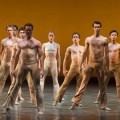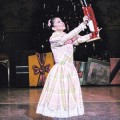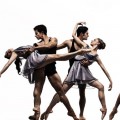With time moving inexorably forward, fewer of the great classical performance works of 18th- and 19th-century Europe can look forward to revivals. This applies no less to the staples of 19th-century Romantic ballet, not least Giselle, the earliest specimen still capable of being revived. The work premiered in Paris, in 1841, with choreography by Jean Coralli and Jules Perrot, and music by Adolphe Adam. While there is no doubt that the old lady can still take breath on the strength of her title role, Adam’s music has gone the distance equally, if exclusively within the balletic context.
Opening Ballet San Jose’s 25th anniversary season, company veteran Karen Gabay took the starring role on Sunday in company director Dennis Nahat’s two-decades-old choreographic update. The performance overall was surprisingly uneven, with the corps—both male and female—lacking precision in the first act, and—women only—in the first part of Act 2. Among the soloists, Gabay used her familiar charm to lift Act 1 even while her dancing isn’t as effortless as in years gone by. Maykel Solas’ Albrecht came up short on both characterization and masculine energy. Jeremy Kovitch’s Hilarion was initially stiff and, despite more apparent testosterone in his confrontations with his rival, proved inconsistent.
In ballet, the line between believability and parody is extremely thin, in both the narrative passages and the dance itself. The big corps ensembles demand precision, or they soon become laughable, as for example the women’s hopping ensemble in Act 2. Rank and file could not find unity of purpose, heads and feet bobbing to any number of different beats.
From her first appearance as the newest Wili in town, Gabay seemed to supply the alchemy that her colleagues had been searching for. From then on, the performance rose to a whole new level: no more gaffes, no more giggles. At last, the women—all now undead Wilis—found their groove, likewise Solas, who, technically, showed real pizzazz (even if his virtuosic pogo stick episode made willing suspension of disbelief a hard call).
In Gabay’s last big adagio, Patricia Whaley’s viola solo bounded out of the pit with more presence and authority than any of the other orchestral solos (perhaps due to the new sound-enhancement system).
Dwight Oltman kept his orchestra on the go and was especially responsive to the onstage principals in Act 2. The sets were cartoonish, the lighting static; Ballet San Jose ought to talk to the designers at Opera San José.

 On the Wine Trail
On the Wine Trail  Chief Davis Retires in Style
Chief Davis Retires in Style 








